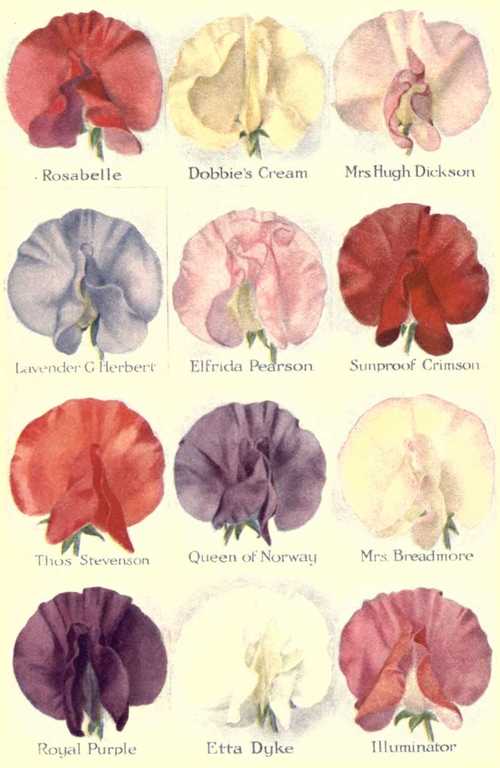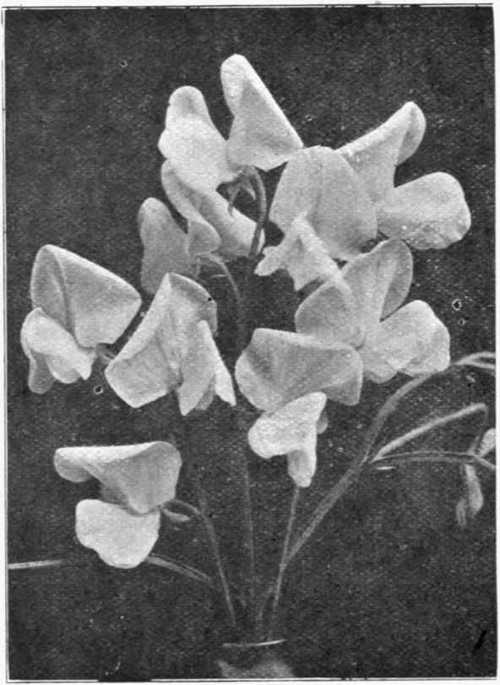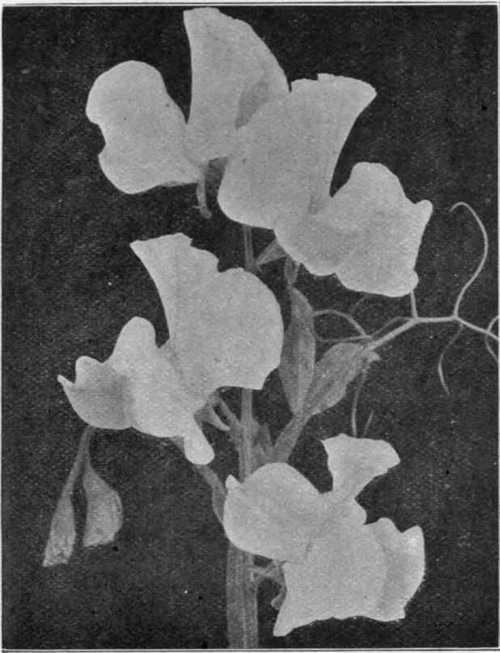Part 1. Chapter 1. The History Of Growing Sweet Peas
Description
This section is from the book "Sweet Peas And Antirrhinums (Snapdragons)", by William Cuthbertson, V.M.H. Also available from Amazon: Sweet Peas And Antirrhinums (Snapdragons).
Part 1. Chapter 1. The History Of Growing Sweet Peas
The Coming of the Modern Sweet Pea.

Twelve Of The Best Modern Sweet Peas
I do not intend to trouble my readers with a long account of the history of the Sweet Pea. A few salient facts must suffice. It is generally agreed that the home of Lathyrus odoratus, the wild Sweet Pea, is the Isles of the Mediterranean, especially Sicily. In 1699, seeds of it were sent to England by a well-known Italian botanist - Franciscus Cupani. He was a devout monk of the Church of Rome, and it strikes one as an interesting coincidence that nearly two hundred years later the work of another reverend Father of the same Church should have a remarkable bearing on the development of the modern Sweet Pea. I refer to Abbé Mendel.
The seeds were sent by Cupani to Dr. Uvedale, of Enfield near London, who grew them in 1700, the plants flowering the same year. It will be remembered by many that 200 years later, in 1900, the bicentenary of the introduction of the Sweet Pea into Great Britain was celebrated by a great exhibition of Sweet Peas at the Crystal Palace, London. My friend, the late Mr. Richard Dean, and I were largely responsible for that great event, out of which sprang the National Sweet Pea Society of England.
By the end of the eighteenth century, the following varieties of Sweet Peas were known to be in existence- purple, red, white, black, and Painted Lady. All these I imagine were simple variations from the original form. There is no record, so far as I know, of anyone having set about the work of raising new varieties scientifically until we come to Laxton and Eckford's work, towards the end of the nineteenth century.
Early in the nineteenth century, a striped variety appeared. In 1837, Messrs. James Carter and Co., of London, offered all the foregoing varieties for sale, and they were the introducers of a number of others, the most noted being Scarlet Invincible, which was the first Sweet Pea to receive a first-class Certificate from the Royal Horticultural Society ; that was in the year 1865.
Before passing to the work of Mr. Henry Eckford, a short reference is necessary to that of Mr. Thomas Laxton. Mr. Laxton was a fine florist of the old school, whom I knew personally.
For ten years, 1883 to 1893, he was identified with new varieties of Sweet Peas. Among the better known varieties introduced by him were Invincible Carmine, Invincible Blue, Etna, Madam Carnot and Princess May.
I now come to Mr. Henry Eckford who has been termed "the father of the Sweet Pea." His name will be for ever associated with the flower. Born in Scotland in 1823, he as a young man migrated to England. While gardener to Dr. Sankey, of Sandywell, Gloucester, he began cross-fertilising Sweet Peas, with a view to their improvement. This was about the year 1870. Mr. Eckford relinquished private service and it was from his gardens at Wem, in Shropshire, that the new Sweet Peas were sent out, which made his name famous wherever flowers are grown, and which gave such an impetus to Sweet Pea culture in America. Beginning in 1882 with Bronze Prince, Mr. Eckford produced a series of new Sweet Peas year by year, which were the wonder and admiration of everyone, until the advent of the waved or Spencer type in 1904.
Mr. Eckford's varieties all belonged in these days to the hooded or erect standard type so well illustrated in the engraving of "Dorothy Eckford."
It is only necessary to mention a few of Mr. Eckford's creations to revive charming memories in the minds of my older readers. In addition to Dorothy Eckford; Queen Alexandra, King Edward, Henry Eckford, Lord Rosebery, Othello, Lady Penzance, Venus, Triumph, Lady Grisel Hamilton, Her Majesty, Primrose, Prima Donna. Duchess of Westminster and Salopian were well known.

"Dorothy Eckford." A Fine Pure White Hooded Flower Raised By Henry Eckford.
"The Modern Sweet Pea" is of course the waved or Spencer Sweet Pea, but without Eckford's work it is very questionable if we should to-day have had the waved Sweet Pea. It came out of one of Eckford's varieties, I believe, as a mutation, as it cropped up in several districts of England about the same time and out of the same variety, "Prima Donna." It is one of the most remarkable things in horticulture that the Sweet Pea, after remaining practically constant in form for 200 years after its introduction into England, should suddenly give rise in several places to the enlarged and beautifully waved form associated with the name of Countess Spencer. The credit of first discovering and introducing this new type will always belong to Mr. Silas Cole, who was gardener to Earl Spencer at Althorp Park, Northampton, in 1901. It was in that year that Mr. Cole set up his remarkable exhibit at the show of the National Sweet Pea Society, at the Royal Aquarium, London, and from 1904, when Countess Spencer was put on the market by Mr. Robert Sydenham, the career of the modern Sweet Pea may be said to have begun. That was only ten years ago, but what a development since!

A Fine Type Of Spencer Or Waved Sweet Pea
Continue to:


